Cercospora leaf spot is a common fungal disease that affects a wide assortment of weeds, shrubs and plants, including flower and vegetable plants. In addition to leaves, the fungus can also affect other parts of the plant like stems, fruit, and seeds. Some of the crops that are more susceptible to cercospora are beets, spinach, Swiss chard, okra, and carrots.
How Do Plants Get Cercospora?
The spores overwinter on plant matter, soil, compost, or fruit from the prior season. When the conditions are right, usually beginning in late spring when temperatures are warm and wet, the dormant spores will be activated. Spores are often transmitted by water droplets. Thus, when water splashes on the soil it can cause the spores to go airborne and land on the plant’s leaves. From there, the spores invade leaf tissue. Spores can also be transported by wind, and an existing infection on an older leaf can become a source for a new infection.
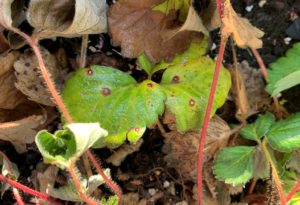
How to Identify
Cercospora leaf spot is characterized by small, round or angular-shaped lesions that generally measure between 1/8 and 1/4 inch (.3 to .6 cm) in diameter. The spots have maroon or purple borders with gray to brown centers. The lesions may also have a yellow “hallow” around the border. Coloration may vary somewhat depending on the species and host plant.
Damage
As the disease progresses, the lesions will enlarge and a gray or purple fuzz will appear as spores develop. This is especially problematic for crops that are grown for their edible leaves like spinach, Swiss chard, beets, turnip greens, etc. If left untreated, leaves will often shrivel and fall off. Lesions can also spread, connect with other lesions, and eventually cover entire leaves making photosynthesis difficult if not impossible. The plant will eventually die.
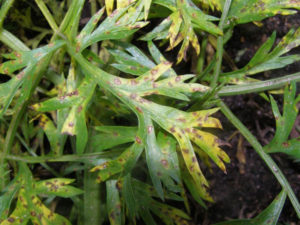
How to Treat Organically
Once you find evidence of cercospora, the sooner it is dealt with, the more successful treatment will be. Here are several options that should be used in combination:
Remove infected leaves because they will become a source of spores and new lesions.
Do not compost any portion of an infected plant, including fruit, seeds, etc. Most compost piles do not maintain high enough temperatures to kill the spores.
This article contains affiliate links. If you make a purchase using one of these links, I will receive a very small commission at no additional cost to you, and it will help me maintain this website. Rest assured, I only recommend products I actually like!
Antifungal agents can be helpful in cercospora management. This is the gallon pump sprayer I use for larger applications like the ones described below.
- Apple cider vinegar. Add one tablespoon of apple cider vinegar (5% acidity) to one gallon of water. Do a test spray on one leaf and wait 24 to 48 hours. If there are no adverse effects, spray the top and underside of leaves and the soil. Repeat every three days as needed. Do not spray in sunlight as the acidity of the vinegar and sunlight can burn plant tissue.
- Hydrogen peroxide. Mix 6 ounces (about 12 tablespoons) of hydrogen peroxide (3%) with one gallon of water. Do a test spray on one leaf and wait 24 to 48 hours. If there are no adverse effects, spray the top and underside of leaves and the soil. Do not use the mixture on seedlings as it will burn them. Repeat once a week as needed.
- Milk spray. Like powdery mildew, which is also a fungal infection, cercospora can be treated with a milk-based spray. Proteins found in animal milk is what makes the spray effective. Therefore, coconut, almond, and other kinds of nut milk will not work. Some recommend adding 3 ounces of animal milk to one gallon of water. However, I use 1 part milk to 8 parts water. Be sure to do a test spray as described above. Apply the spray during daylight hours as the proteins require sunlight to be activated. Repeat once a week as needed.
- Neem oil. Many gardeners know that neem oil is an effective organic insecticide, but it can also be an effective fungicide. Be sure to use a cold-pressed neem oil with the naturally occurring chemical called Azadirachtin. This is the brand I use. Be sure to follow directions and do a test spray.
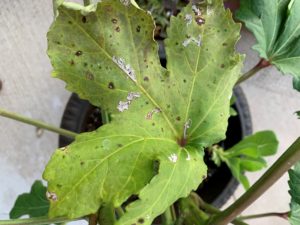
- Liquid Copper. Some recommend the use of copper, a known fungicide, especially for severe cases of cercospora leaf spot. However, I personally do not advocate its use. While copper is a naturally occurring mineral, it is combined with copper octanoate, or copper soap, to combat fungal infections in plants. However, other chemicals, like copper sulfate, are also added. Although copper sulfate is classified as being organic and said to be safe to use in the garden, several studies have found that it can be toxic to humans, animals, and bees.[1] The Genetic Literacy Project reports:
It has been assumed for years that pesticides that occur naturally (in certain plants, for example) are somehow better for us and the environment than those that have been created by man. As more research is done into their toxicity, however, this simply isn’t true, either. Many natural pesticides have been found to be potential – or serious – health risks.[2]
The use of liquid copper calls for wearing protective gear including clothing to protect the skin, eyewear protection, filtered mask, gloves, etc. In my opinion, I would not use liquid copper in my garden, especially, when there are other alternatives.
How to Prevent
Proper plant spacing creates better airflow and thus dryer plants, a deterrent for the fungus which requires warm, damp conditions to propagate.
Crop rotation is a helpful measure to take against the buildup of cercospora spores in the soil.
Careful watering. Use an irrigation system, soaker hose, or water by hand with a low-pressure at ground level to minimize splashing. Also, water in the morning so that plants can dry before evening.
Mulch creates a protective barrier and thus helps minimize the spread of spores from the soil. Mulch will also help the soil retain moisture so that you can water less frequently, thus keeping the “splash” factor to a minimum.
Remove plant debris regularly because it can harbor cercospora spores.
Practice good garden hygiene. Make sure garden tools are cleaned with rubbing alcohol after use so that spores are not transferred from one plant to another. (You can learn about other effective options for disinfecting tools in this helpful article.) Also, disinfect containers and seed pots before repotting with new seeds or plants. A bleach solution of 1 part bleach to 9 parts water works well.
Neem oil, as described above, can also help as a preventative measure. Be sure to do a test follow directions and do a test spray.
Cercospora leaf spot is a common fungal disease that, if caught and treated early, should not interfere with a bountiful harvest.
Thank you for reading this article! If you found it helpful, please consider sharing it with others via email or social media!
[1] Andrew Porterfield, “Organic Fungicide Copper Sulfate Poses Dangers to Humans, Animals, Insects—How Does It Compare to Conventional Pesticides?” Genetic Literacy Project, 11-16-18, updated 7-23-20, accessed 5-18-21, https://geneticliteracyproject.org/2018/11/16/organic-fungicide-copper-sulfate-poses-dangers-to-humans-animals-insects-how-does-it-compare-to-conventional-pesticides/
[2] Ibid.
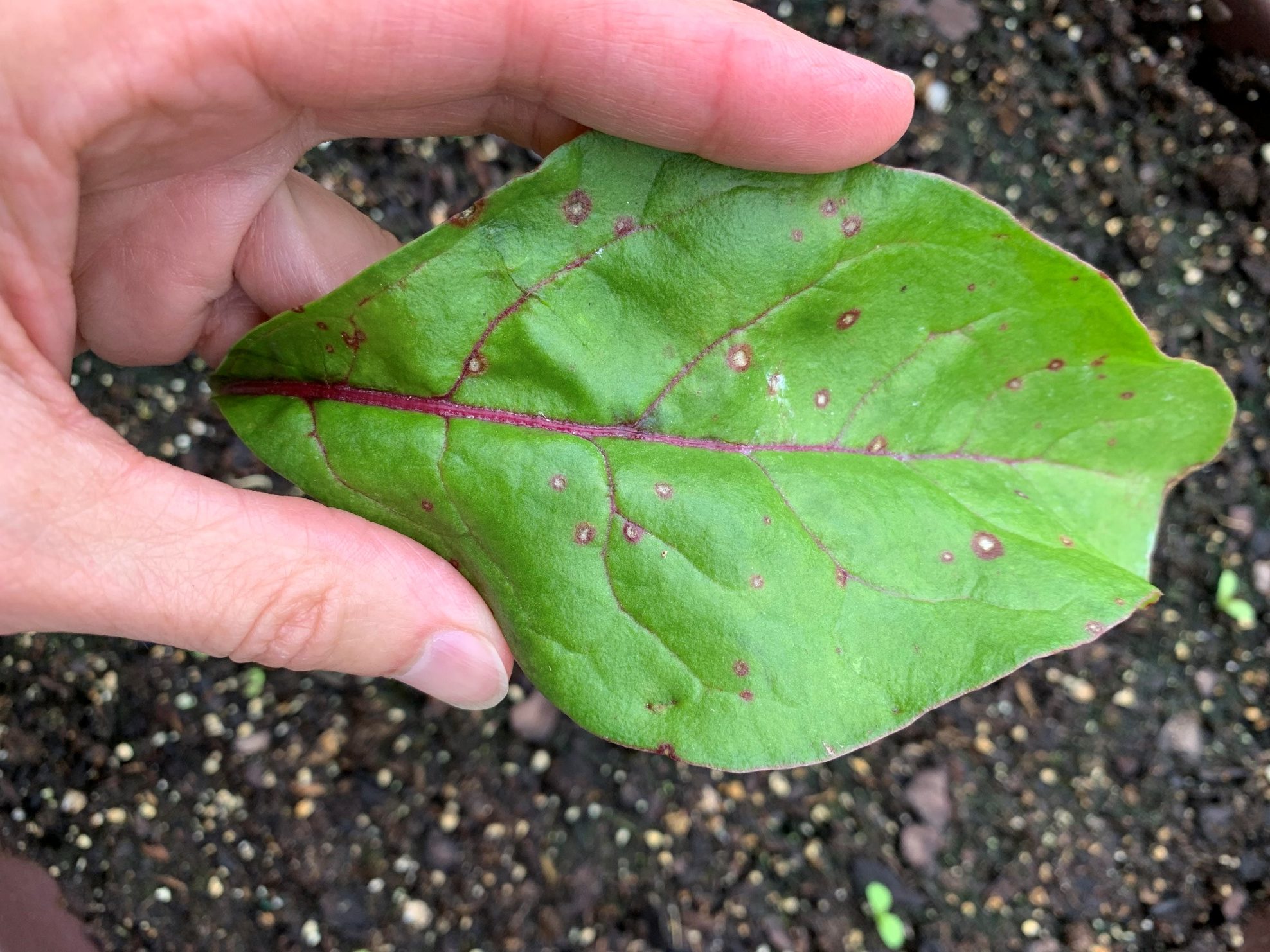
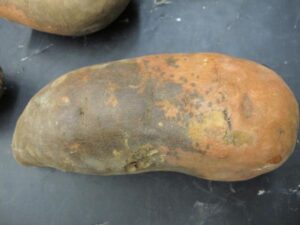
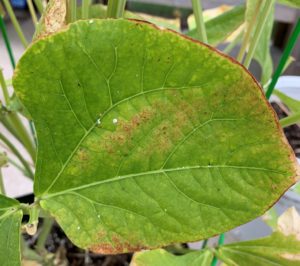
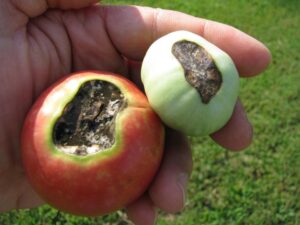
can we use sesame oil for treatment of cercospora in aquaponics
Thanks for reaching out! I have never used sesame oil as an antifungal agent in the garden. I did a bit of research and could not find any articles on the subject. Sesame oil can go rancid so that may be a concern, especially in a closed system like an aquaponics system. Hope that helps! Best wishes!
I did not know that my swiss chard and beets had this fungus until this year. I am a new gardener and am learning. I already saw this last year in my garden but had no idea it was a fungus and very contagious for other plants as well. I have unfortunatly but contaminated leaves in my compost and now I am not sure what to do about my compost. Can I use a natural product to treat my compost like EM? Or can I leave my compost alone for 2 years and then use it? Or should I just get rid of my compost all together and start a new fresh one in a different location? Also what can I do to treat the soil of an infected area? EM? Thank you for any advice
Hi Christa,
Thanks for reaching out. I understand your concerns about adding diseased leaves to your compost pile. It happens to us all in one area or another. We are all learning!
To answer your question, it depends on how big the compost pile is. If it is small, it would be easier to bag it, throw it away, and start over. Alternatively, you could leave it alone for a few years like you would an infected bed. On the other hand, if your compost pile is big enough, or you can increase its size, you can kill the pathogens by heating the pile to between 140 F, but not greater than 180 F, for about two weeks. (A compost pile needs to have a mass of about 3 feet cubed in order to generate enough heat to kill pathogens.) Once the pile heats up, turn it to incorporate more oxygen and to ensure all portions of the pile heat up. As for infected soil, do not plant anything in that spot for a few years. If you really need the space, you can try planting different crops with resistant varieties. Hope this helps! Best wishes!
Thank you for this post. My bottle of hydrogen peroxide says 3%. Do I spray it on directly or dilute the 3% hydrogen peroxide so it’s 3% of the total? Thanks!
Thanks for your question, Cherie. Sounds like you have the right kind of hydrogen peroxide (3%). To clarify, you will need to dilute it before spraying it on your plants. So add 6 ounces of the hydrogen peroxide to 1 gallon of water. Mix well and do a test spray to make sure it is not too strong. If there is no damage to the test leaf, you can proceed with that ratio. If you find it burns the test leaf, dilute the mixture and perform another test. Feel free to refer to the article for more details. Best wishes!
Thank you for this very informative article. I planted a batch of Hibiscus sabdariffa from seed and everything went ok till today, when I found all their leaves spoted with what I supose to be a fungal attack by Cercospora. I start today with a treatment with buttermilk.
Alejandro,
Thanks for letting me know the article was helpful! Sorry to hear the Hibiscus sabdariffa have a fungal issue, but hopefully, you’ll see some improvement soon!
Take care 🙂